Keeper
Active Member
Okay with my recent issues with oil leaks and such I figured a thread that tried to address these issues might save someone else the headache of a complete teardown to fix them.
It seems that every little thing that can get you, got me on my build most resulted in a leak of some sort luckily nothing caused more then a dirty driveway. Its amazing that you spend so much time checking tolerances, torque settings and 1000 other things to make sure things run you miss all the little things, that unless you do this all the time, make up most of the mistakes.
My issues are specific for my SBC, but I am sure will apply to damn near everything else.
- check your parts for flatness - as I found out, even brand new parts need to be checked.
- make sure the gaskets that came with the kit are correct for your application - The hard "blue" felpro gaskets are not for aluminum intakes!
- oil seals such as the harmonic balancer seal need to be coated with locite or equiv before being driven into the cover - I thought my rubber seal was bad, turns out it was leaking around the outside of the seal as I did not realize it needed a sealer...
- clean clean clean clean clean - gasket sealer will not seal to a dirty block (see other post covering my oil leaks)
- make sure your water pump is not hitting the timing cover - the resulting leak is a pain to try and fix and no matter how much you tighten it, it won't stop.
- use thread sealer on every intake bolt, not just the water jacket ones.
Please add any other got-ya avoidance items you may have. I know there are some I have missed in here but if I remember them I will add them.
It seems that every little thing that can get you, got me on my build most resulted in a leak of some sort luckily nothing caused more then a dirty driveway. Its amazing that you spend so much time checking tolerances, torque settings and 1000 other things to make sure things run you miss all the little things, that unless you do this all the time, make up most of the mistakes.
My issues are specific for my SBC, but I am sure will apply to damn near everything else.
- check your parts for flatness - as I found out, even brand new parts need to be checked.
- make sure the gaskets that came with the kit are correct for your application - The hard "blue" felpro gaskets are not for aluminum intakes!
- oil seals such as the harmonic balancer seal need to be coated with locite or equiv before being driven into the cover - I thought my rubber seal was bad, turns out it was leaking around the outside of the seal as I did not realize it needed a sealer...
- clean clean clean clean clean - gasket sealer will not seal to a dirty block (see other post covering my oil leaks)
- make sure your water pump is not hitting the timing cover - the resulting leak is a pain to try and fix and no matter how much you tighten it, it won't stop.
- use thread sealer on every intake bolt, not just the water jacket ones.
Please add any other got-ya avoidance items you may have. I know there are some I have missed in here but if I remember them I will add them.




